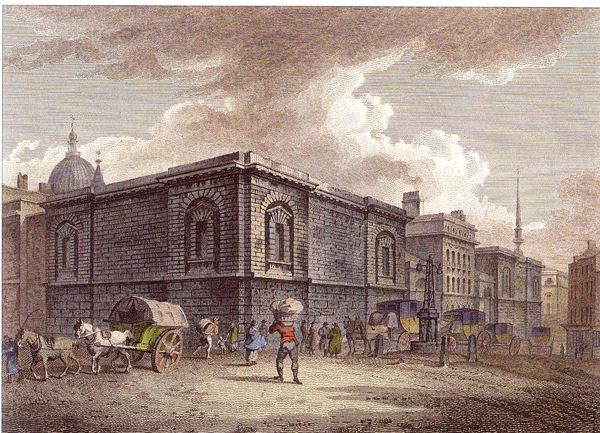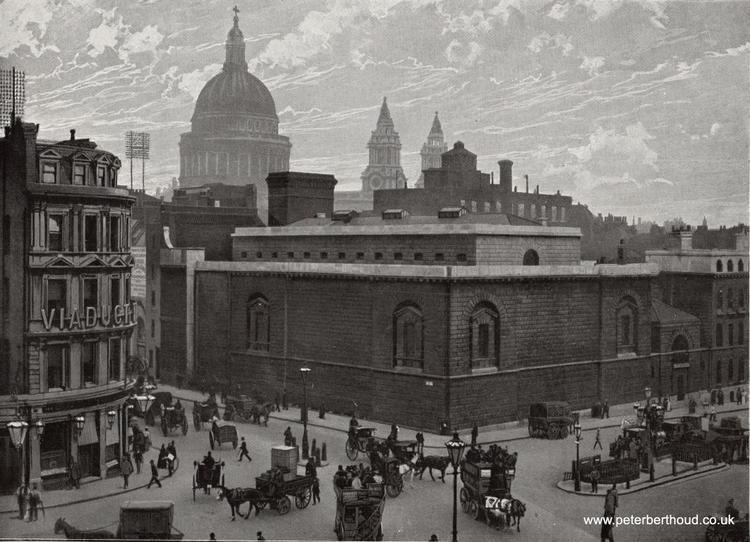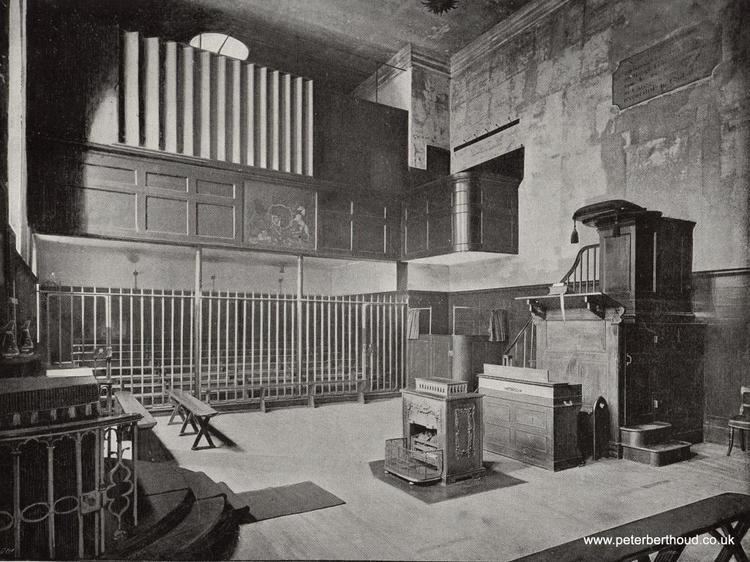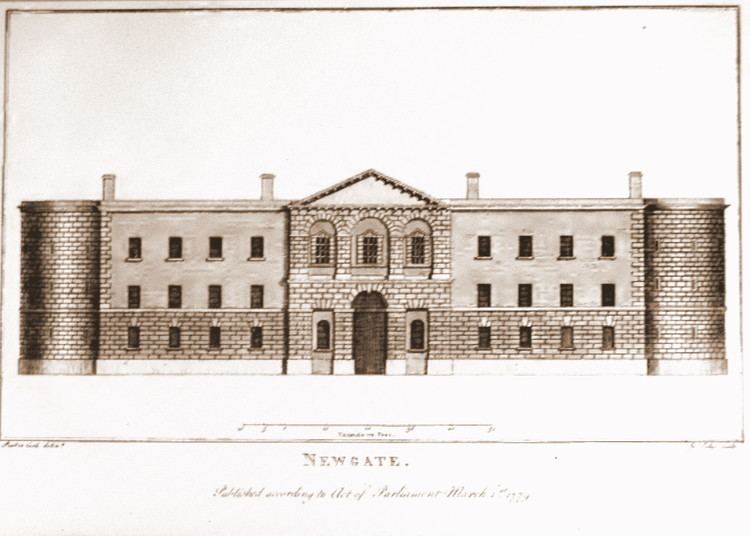Destruction date 1902 Destroyed by Demolition | Opened 1769 Architect George Dance the Younger | |
 | ||
Architectural styles Classical architecture, Palladian architecture, Piranesian Architecture Similar | ||
The old bailey newgate prison bbc tv news 2006
Newgate Prison was a prison in London, at the corner of Newgate Street and Old Bailey just inside the City of London. It was originally located at the site of Newgate, a gate in the Roman London Wall. The gate/prison was rebuilt in the 12th century, and demolished in 1904. The prison was extended and rebuilt many times, and remained in use for over 700 years, from 1188 to 1902.
Contents
- The old bailey newgate prison bbc tv news 2006
- Newgate prison documentary
- History
- Prison Life
- Executions
- Demolition
- Famous prisoners
- In literature
- In popular culture
- References

Newgate prison documentary
History

In the early 12th century, Henry II instituted legal reforms that gave the Crown more control over the administration of justice. As part of his Assize of Clarendon of 1166, he required the construction of prisons, where the accused would stay while royal judges debated their innocence or guilt and subsequent punishment. In 1188, Newgate was the first institution established to meet that purpose.

A few decades later in 1236, in an effort to significantly enlarge the prison, the king converted one of the Newgate turrets, which still functioned as a main gate into the city, into an extension of the prison. The addition included new dungeons and adjacent buildings, which would remain unaltered for roughly two centuries.

By the 15th century, however, Newgate was in need of repair. The building was collapsing and decaying, and many prisoners were dying from the close quarters, overcrowding, rampant disease, and bad sanitary conditions. Indeed, one year, 22 prisoners died from "gaol fever." The situation in Newgate was so dire that in 1419, city officials temporarily shut down the prison.

Some Londoners bequeathed their estates to repair the prison. Following pressure from reformers who learned that the women’s quarters were too small and did not contain their own bathrooms, thus forcing women to walk through the men’s quarters to reach one, officials added a separate tower and chamber for female prisoners in 1406.

Two decades later, the executors of Lord Mayor Dick Whittington were granted a license to renovate the prison in 1422. The gate and gaol were pulled down and rebuilt. There was a new central hall for meals, a new chapel, and the creation of additional chambers and basement cells with no light or ventilation. The prison housed both male and female felons and debtors and separated the prisoners into wards by gender. By the mid-15th century, Newgate could accommodate roughly 300 prisoners. Though the prisoners lived in separate quarters, they mixed freely with each other and visitors to the prison.
There were three main wards—the Master’s side for those could afford to pay for their own food and accommodations, the Common side for those who were too poor, and a Press Yard for special prisoners. The king often used Newgate as a holding place for heretics, traitors, and rebellious subjects brought to London for trial.
The prison was destroyed in the Great Fire of London in 1666, and was rebuilt in 1672 by Sir Christopher Wren, extending into new buildings on the south side of the street.
In 1770, Parliament having granted £50,000 towards the cost, the City of London provided a piece of ground 1,600 feet (500 m) long and 50 feet (15 m) deep to enlarge the site of the prison and to build a new sessions house. The work followed the designs of George Dance and was almost finished when it was stormed by a mob during the Gordon riots in June 1780. The building was gutted by fire, and the walls badly damaged. The cost of repairs was estimated at £30,000. Dance’s new prison was finally completed in 1782.
The new prison was constructed to an architecture terrible design intended to discourage law-breaking. The building was laid out around a central courtyard, and was divided into two sections: a "Common" area for poor prisoners and a "State area" for those able to afford more comfortable accommodation. Each section was further sub-divided to accommodate felons and debtors.
Prison Life
All manner of criminals stayed at Newgate. Some committed acts of petty crime and theft, breaking and entering homes or committing highway robberies, while others performed serious crimes such as rapes and murders. The number of prisoners in Newgate for specific types of crime often grew and fell, reflecting public anxieties of the time. For example, towards the tail end of Edward I's reign, there was a rise in street robberies. As such, the punishment for drawing out a dagger was 15 days in Newgate; injuring someone meant 40 days in the prison.
Upon their arrival in Newgate, prisoners were chained and led to the appropriate dungeon for their crime. Those who had been sentenced to death stayed in a cellar beneath the keeper’s house, essentially an open sewer lined with chains and shackles to encourage submission. Otherwise, common debtors were sent to the "stone hall" whereas common felons were taken to the "stone hold." The dungeons were dirty and unlit, so depraved that physicians would not enter.
The conditions did not improve with time. Prisoners who could afford to purchase alcohol from the prisoner-run drinking cellar by the main entrance to Newgate remained perpetually drunk. There were lice everywhere, and jailers left the prisoners chained to the wall to languish and starve. The legend of the "Black Dog," an emaciated spirit thought to represent the brutal treatment of prisoners, only served to emphasize the harsh conditions. From 1315 to 1316, 62 deaths in Newgate were under investigation by the coroner, and prisoners were always desperate to leave the prison.
The cruel treatment from guards did nothing to help the unfortunate prisoners. According to medieval statute, the prison was to be managed by two annually elected Sheriffs, who in turn would sublet the administration of the prison to private "gaolers", or "Keepers", for a price. These Keepers in turn were permitted to exact payment directly from the inmates, making the position one of the most profitable in London. Inevitably, often the system offered incentives for the Keepers to exhibit cruelty to the prisoners, charging them for everything from entering the gaol to having their chains both put on and taken off. They often began inflicting punishment on prisoners before their sentences even began. Guards, whose incomes partially depended on extorting their wards, charged the prisoners for food, bedding, and to be released from their shackles. To earn additional money, guards blackmailed and tortured prisoners. Among the most notorious Keepers in the Middle Ages were the 14th-century gaolers Edmund Lorimer, who was infamous for charging inmates four times the legal limit for the removal of irons, and Hugh De Croydon, who was eventually convicted of blackmailing prisoners in his care.
Indeed, the list of things that prison guards were not allowed to do serve as a better indication of the conditions in Newgate than the list of things that they were allowed to do. Gaolers were not allowed to take alms intended for prisoners. They could not monopolize the sale of food, charge excessive fees for beds, or demand fees for bringing prisoners to the Old Bailey. In 1393, new regulation was added to prevent gaolers from charging for lamps or beds.
Not a half century later, in 1431, city administrators met to discuss other potential areas of reform. Proposed regulations included separating freemen and freewomen into the north and south chambers, respectively, and keeping the rest of the prisoners in underground holding cells. Good prisoners who had not been accused of serious crimes would be allowed to use the chapel and recreation rooms at no additional fees. Meanwhile, debtors whose burden did not meet a minimum threshold would not be required to wear shackles. Prison officials were barred from selling food, charcoal, and candles. The prison was supposed to have yearly inspections, but whether or not they actually occurred is unknown. Other reforms attempted to reduce the waiting time between jail deliveries to the Old Bailey, with the aim of reducing suffering, but these efforts had little effect.
Over the centuries, Newgate was used for a number of purposes including imprisoning people awaiting execution, although it was not always secure: burglar Jack Sheppard twice escaped from the prison before he went to the gallows at Tyburn in 1724. Prison chaplain Paul Lorrain achieved some fame in the early 18th century for his sometimes dubious publication of Confessions of the condemned.
Executions
In 1783, the site of London's gallows was moved from Tyburn to Newgate. Public executions outside the prison – by this time, London's main prison – continued to draw large crowds. It was also possible to visit the prison by obtaining a permit from the Lord Mayor of the City of London or a sheriff. The condemned were kept in narrow sombre cells separated from Newgate Street by a thick wall and receiving only a dim light from the inner courtyard. The gallows were constructed outside a window in Newgate Street. Until the 20th century, future British executioners were trained at Newgate; one of the last was John Ellis in 1901.
During the early 19th century the prison attracted the attention of the social reformer Elizabeth Fry. She was particularly concerned at the conditions in which female prisoners (and their children) were held. After she presented evidence to the House of Commons improvements were made. In 1858, the interior was rebuilt with individual cells.
From 1868, public executions were discontinued and executions were carried out on gallows inside Newgate. Michael Barrett was the last man to be hanged in public outside Newgate Prison (and the last person to be publicly executed in Great Britain) on 26 May 1868. In total (publicly or otherwise), 1,169 people were executed at the prison.
Demolition
The prison closed in 1902, and was demolished in 1904. The Central Criminal Court (also known as the Old Bailey after the street on which it stands) now stands upon its site.
The original door from a prison cell used to house St. Oliver Plunkett in 1681 is on display at St. Peter's Church in Drogheda, Ireland. The original iron gate leading to the gallows was used for decades in an alleyway in Buffalo, New York, USA and is currently housed in that city at Canisius College.
Famous prisoners
Other famous prisoners at Newgate include:
In literature
In popular culture
The phrase "[as] black as Newgate's Knocker" is a Cockney reference to the door knocker on the front of the prison.
